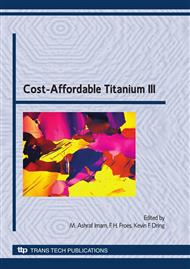p.141
p.149
p.157
p.165
p.171
p.179
p.185
p.195
p.205
Microstructure and Mechanical Properties of α’ Martensite Type Ti-V-Al Alloy after Cold- or Hot Working Process
Abstract:
Ti alloys are widely utilized for industrial applications due to their excellent mechanical properties combined with low density. In general, Ti alloys are classified as , + and alloys, with further subdivision into near and metastable alloys. Quite recently, we have presented new type structural ’ martensite (H.C.P.) Ti alloys with low Young’s modulus, high strength and excellent ductility at room temperature. In this work, we examined the microstructure and mechanical properties of ’ martensite type Ti-V-Al alloy after cold- or hot working process. Then, we found that deformation behavior of ’ initial microstructure as compared with (+) initial microstructure was different based on the results of stress-strain curves and Processing Maps under the hot working process. Further, cold rolled ’ martensite microstructure exhibited the refined equiaxed dislocation cell structure, thereby resulting in high strength. This result suggests the new type deformation processing (for both cold- and hot work processing) utilizing ’ martensite in industrial Ti alloys.
Info:
Periodical:
Pages:
171-177
Citation:
Online since:
May 2010
Keywords:
Price:
Сopyright:
© 2010 Trans Tech Publications Ltd. All Rights Reserved
Share:
Citation:


